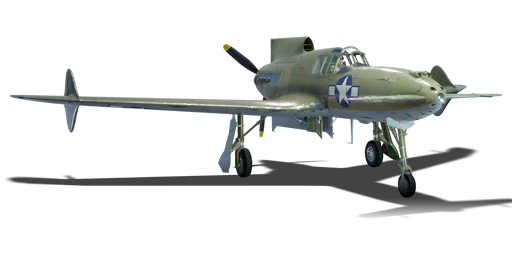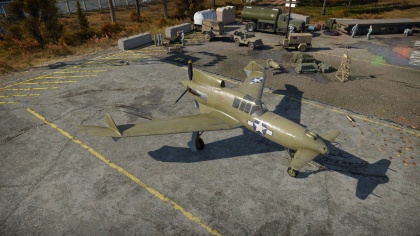Difference between revisions of "XP-55"
m (Added notice of BR discrepancy) |
Inceptor57 (talk | contribs) m (BR discrepancy fixed) |
||
| Line 1: | Line 1: | ||
| − | |||
{{Specs-Card | {{Specs-Card | ||
|code=xp-55 | |code=xp-55 | ||
| Line 9: | Line 8: | ||
[[File:GarageImage_{{PAGENAME}}.jpg|420px|thumb|left]] | [[File:GarageImage_{{PAGENAME}}.jpg|420px|thumb|left]] | ||
{{break}} | {{break}} | ||
| − | The '''{{Specs|name}}''' is a premium rank {{Specs|rank}} American fighter {{Battle-rating}}. It was introduced in [[Update 1.31]] | + | The '''{{Specs|name}}''' is a premium rank {{Specs|rank}} American fighter {{Battle-rating}}. It was introduced in [[Update 1.31]]. |
The XP-55 Ascender is unlike anything you will fly in the U.S. Tech Tree. Flying this aircraft effectively requires a dedication to Energy Fighting. The XP-55 excels greatly in the ability to climb and dive and this is your greatest advantage. The Ascender has decent maneuverability and best used in a Boom & Zoom function. All four of this aircraft's armament are packed tightly in the nose for devastating results. | The XP-55 Ascender is unlike anything you will fly in the U.S. Tech Tree. Flying this aircraft effectively requires a dedication to Energy Fighting. The XP-55 excels greatly in the ability to climb and dive and this is your greatest advantage. The Ascender has decent maneuverability and best used in a Boom & Zoom function. All four of this aircraft's armament are packed tightly in the nose for devastating results. | ||
Revision as of 14:55, 30 July 2019
Contents
Description
The XP-55 Ascender is a premium rank III American fighter
with a battle rating of 3.7 (AB), 4.3 (RB), and 3.0 (SB). It was introduced in Update 1.31.
The XP-55 Ascender is unlike anything you will fly in the U.S. Tech Tree. Flying this aircraft effectively requires a dedication to Energy Fighting. The XP-55 excels greatly in the ability to climb and dive and this is your greatest advantage. The Ascender has decent maneuverability and best used in a Boom & Zoom function. All four of this aircraft's armament are packed tightly in the nose for devastating results.
General info
Flight Performance
Describe how the aircraft behaves in the air. Speed, manoeuvrability, acceleration and allowable loads - these are the most important characteristics of the vehicle.
| Characteristics | |||||||
|---|---|---|---|---|---|---|---|
| Stock | |||||||
| Max Speed (km/h at 5,000 m) |
Max altitude (meters) |
Turn time (seconds) |
Rate of climb (meters/second) |
Take-off run (meters) | |||
| AB | RB | AB | RB | AB | RB | ||
| 601 | 589 | 10500 | 30.3 | 30.8 | 13.3 | 15.3 | 232 |
| Upgraded | |||||||
| Max Speed (km/h at 5,000 m) |
Max altitude (meters) |
Turn time (seconds) |
Rate of climb (meters/second) |
Take-off run (meters) | |||
| AB | RB | AB | RB | AB | RB | ||
| 656 | 628 | 10500 | 28.8 | 29.2 | 26.2 | 18.6 | 232 |
Details
| Features | ||||
|---|---|---|---|---|
| Combat flaps | Take-off flaps | Landing flaps | Air brakes | Arrestor gear |
| ✓ | ✓ | ✓ | X | X |
| Limits | ||||
|---|---|---|---|---|
| Wing-break speed (km/h) |
Gear limit (km/h) |
Combat flap (km/h) |
Max Static G | |
| + | - | |||
| 550 | ~14 | ~8 | ||
| Optimal velocities | |||
|---|---|---|---|
| Ailerons (km/h) |
Rudder (km/h) |
Elevators (km/h) |
Radiator (km/h) |
| < 463 | < 460 | < 520 | > 250 |
| Compressor (RB/SB) | ||
|---|---|---|
| Setting 1 | ||
| Optimal altitude | 100% Engine power | WEP Engine power |
| 4,724 m | 1,125 hp | 1,277 hp |
Survivability and armour
- 9.5 mm Steel - Armor plate behind pilot's headrest
Armaments
Offensive armament
The XP-55 is armed with:
- 2 x 20 mm AN/M2 cannons, nose-mounted (200 rpg = 400 total)
- 2 x 12.7 mm Browning M2 machine guns, nose-mounted (200 rpg = 400 total)
Usage in battles
Describe the tactics of playing in an aircraft, the features of using vehicles in a team and advice on tactics. Refrain from creating a "guide" - do not impose a single point of view, but instead, give the reader food for thought. Examine the most dangerous enemies and give recommendations on fighting them. If necessary, note the specifics of the game in different modes (AB, RB, SB).
Manual Engine Control
| MEC elements | ||||||
|---|---|---|---|---|---|---|
| Mixer | Pitch | Radiator | Supercharger | Turbocharger | ||
| Oil | Water | Type | ||||
| Controllable | Not controllable | Not controllable | Not controllable | Separate | Not controllable | Not controllable |
Modules
| Tier | Flight performance | Survivability | Weaponry | |
|---|---|---|---|---|
| I | Fuselage Repair | Radiator | Offensive 12 mm | |
| II | Compressor | Airframe | New 12 mm MGs | |
| III | Wings Repair | Engine | Offensive 20 mm | |
| IV | Engine Injection | Cover | New 20 mm Cannons | |
Pros and cons
Pros:
- Good maneuverability
- Good climb rate
- Insanely high dive speed, unbreakable wings
- Insane acceleration in a dive
- Has some quite good, nose-mounted armament
- Outstanding energy retention in level flight, after a dive
- Awesome weapons in a tight spread, all in the nose
Cons:
- Cannot snap-roll at all unless you want a stall spin
- Roll rate is somewhat lacking compared to most contemporaries
- Almost no armor, especially from the front. Head ons and bomber hunting are not advised
History
The U.S. Army sponsored three prototypes for a new pusher power-plant propelled fighter in 1941. Out of this was born the Vultee XP-54, Northrop XP-56 Black Bullet, and the Curtiss-Wright XP-55 Ascender. Four airframes were built for testing the Ascender. The first aircraft was delivered on July 13, 1943. During its testing, they discovered it required a long take-off run for the nose-mounted elevator to become effective. Before the issue could be addressed the aircraft was lost on November 15th. The second and third XP-55 flew in the spring of 1944. The second aircraft was used as a testbed for armament. On May 27, 1945, the third XP-55 took flight for public display over a crowd of 100,000 people. When the XP-55 crossed the airfield the pilot began to roll the aircraft. Without warning, the aircraft dove straight into the ground while being inverted. The pilot was thrown from the wreckage and suffered severe injuries. A nearby bystander was killed. After testing, the Ascender was judged to have poor performance and handling. The design was ultimately deemed too ineffective for a fighter. Although the XP-55 program was plagued with issues, it made numerous contributions to aircraft design. The second XP-55 is still on display today at the Smithsonian Institute's National Air and Space Museum in Washington D.C.
In-game description
"Curtiss-Wright XP-55 Ascender single-engine army interceptor fighter prototype
The Curtiss-Wright XP-55 (company designation CW-24) prototype interceptor fighter was developed to meet the requirements of Proposal R-40C, issued by the United States Army Air Corps on November 27, 1939. It called for the creation of a fighter outperforming all existing models in speed, rate of climb, manoeuvrability, armament, and pilot visibility. In addition, it required that the new fighter would have small production and maintenance costs. The R-40C requirements specifically mentioned that the aircraft to be created should have an unconventional aerodynamic configuration.
The aircraft created by the Curtiss-Wright designers had a canard configuration with swept wings and a pusher propeller. The swept wings had ailerons and flaps, and small fins with rudders were fitted at the wing tips. The horizontal empennage was under the wings. The CW-24 had a tricycle landing gear with a nosewheel.
The Curtiss Company also proposed using the new, yet untested Pratt & Whitney X-1800 liquid-cooled engine, mounted behind the pilot and driving the pusher propeller.
On 10 July 1942, the US Army Air Corps ordered three prototype aircraft, which received the army designation of ХР-55.
Since there was much difficulty with the further development of the Pratt & Whitney X-1800 engine, the company's specialists decided to use an Allison V-1710-95 twelve-cylinder, V-type, liquid-cooled engine, which produced a takeoff power of 1,275 hp.
The aircraft's armament consisted of four 12.7 mm Colt-Browning AN-M2.5 machine guns with 200 rounds each. Two 20 mm Bendix-Hispano AN-M2C cannons, with 200 rounds each, were planned to be mounted on this series, as well.
The ХР-55 prototype (Ser No. 42-78845) performed its first flight on July 19, 1943, at Scott Field Air Force Base, not far from the Curtiss-Wright factory in St. Louis. The tests showed that the ХР-55 had satisfactory controllability when flying horizontally or gaining altitude, but the pilots experienced some inconveniences when landing or flying at low speeds, as they could not feel any load on the elevator. There were also some cooling problems with the Allison V-1710-95 engine, which was located in the rear section of the airframe.
The ХР-55's characteristics were not particularly outstanding, and even inferior to those of fighters of classic conventional configuration already in service. Besides, it became quite evident by early 1944 that further fighter development would employ not piston but turbojet engines.
As a result, no order for full-scale production followed, and all work on the ХР-55 was discontinued."
Media
Excellent additions to the article would be video guides, screenshots from the game, and photos.
See also
External links
Paste links to sources and external resources, such as:
- topic on the official game forum;
- encyclopedia page on the aircraft;
- other literature.
| USA fighters | |
|---|---|
| P-26 Peashooter | P-26A-33 · P-26A-34 · P-26A-34 M2 · P-26B-35 |
| P-36 Hawk | P-36A · Rasmussen's P-36A · P-36C · ○P-36C · P-36G |
| P-39 Airacobra | P-400 · P-39N-0 · P-39Q-5 |
| P-40 | P-40C · P-40E-1 · P-40E-1 TD · P-40F-10 |
| P-43 Lancer | P-43A-1 |
| P-47 Thunderbolt | P-47D-22-RE · P-47D-25 · P-47D-28 · P-47M-1-RE · ⋠P-47M-1-RE · P-47N-15 |
| P-51 Mustang | P-51 · P-51A (Thunder League) · P-51C-10 · P-51D-5 · P-51D-10 · P-51D-20-NA · P-51D-30 · P-51H-5-NA |
| P-63 Kingcobra | P-63A-5 · P-63A-10 · P-63C-5 · ␠Kingcobra |
| Prototypes | XP-55 |
| F2A Buffalo | F2A-1 · Thach's F2A-1 · F2A-3 |
| BF2C | BF2C-1 |
| F3F | F3F-2 · Galer's F3F-2 |
| F4F Wildcat | F4F-3 · F4F-4 |
| F4U Corsair | F4U-1A · F4U-1A (USMC) · F4U-1D · F4U-1C · F4U-4 · F4U-4B · F4U-4B VMF-214 · F2G-1 |
| F6F Hellcat | F6F-5 · F6F-5N |
| F8F Bearcat | F8F-1 · F8F-1B |
| Other countries | ▃Ki-43-II · ▃Ki-61-Ib · ▃A6M2 · ▃Bf 109 F-4 · ▃Fw 190 A-8 · ▃Spitfire LF Mk IXc |
| USA premium aircraft | |
|---|---|
| Fighters | Thach's F2A-1 · Galer's F3F-2 · F2G-1 · F4U-4B VMF-214 · P-26A-34 · Rasmussen's P-36A · P-40C · P-43A-1 |
| P-47M-1-RE · ⋠P-47M-1-RE · P-51A · P-51D-10 · P-51D-20-NA · ␠Kingcobra · XP-55 | |
| ▃A6M2 · ▃Ki-43-II · ▃Ki-61-Ib · ▃Bf 109 F-4 · ▃Fw 190 A-8 · ▃Spitfire LF Mk IXc | |
| Twin-engine fighters | XP-38G · Bong's P-38J-15 · P-38K · YP-38 · P-61A-11 · XF5F · XP-50 · F7F-3 |
| Jet fighters | P-59A · F-86F-35 · F-89B · F-89D · F-4S Phantom II · F-5C · F-20A |
| Strike aircraft | A-1H · A2D-1 · AU-1 · XA-38 · AV-8A · AV-8B (NA) · A-6E TRAM · A-10A |
| Bombers | A-26C-45DT · B-10B · BTD-1 · PBM-3 "Mariner" · PBM-5A "Mariner" · PV-2D |





